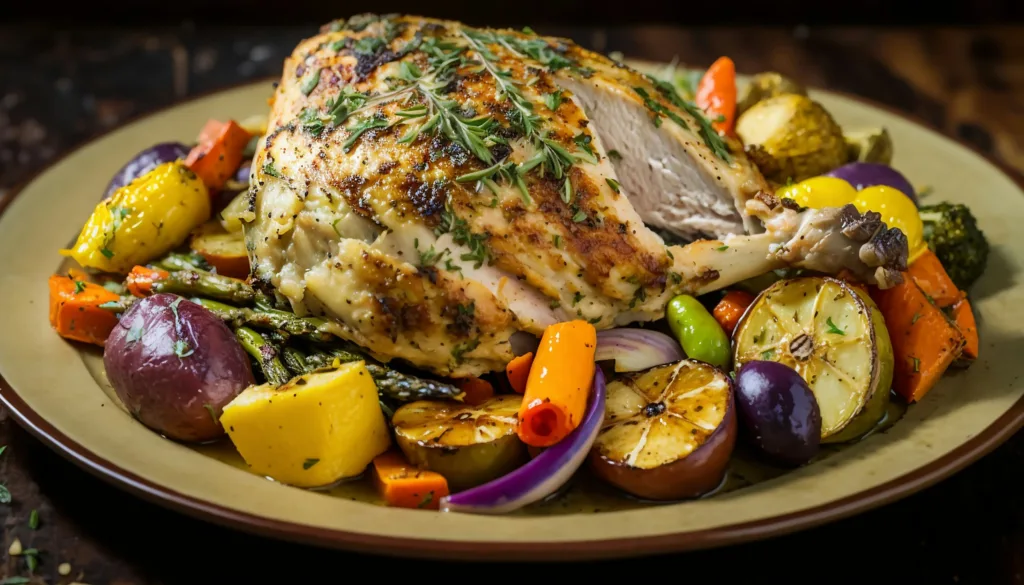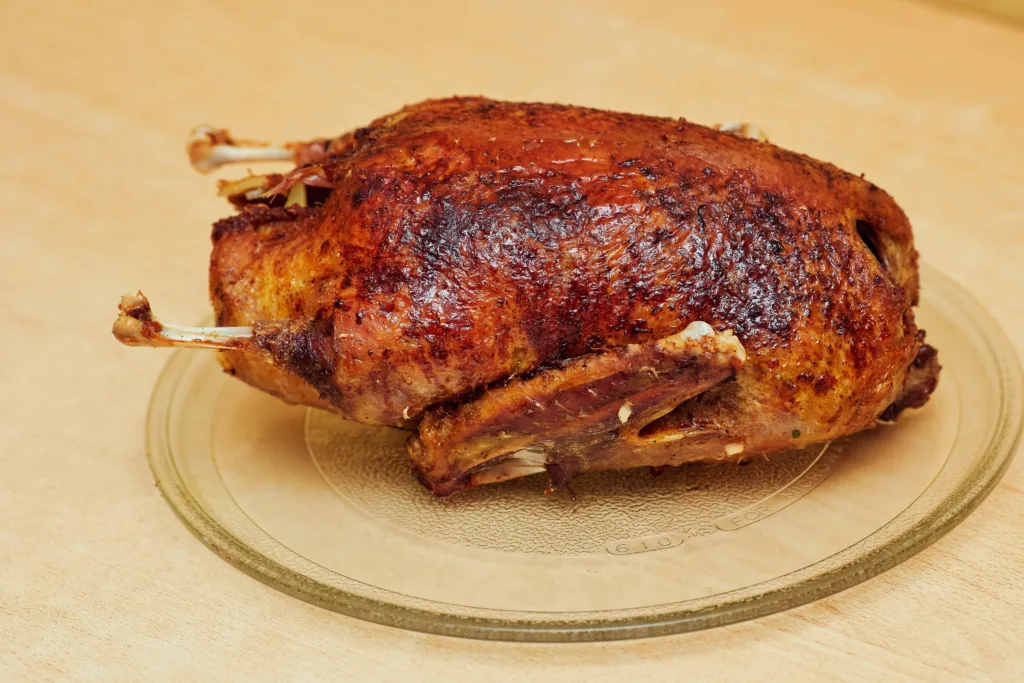Rotisserie chicken is that weeknight dinner lifesaver – already cooked, budget-friendly, and ready to be tossed into just about anything. But there’s always that lingering question: is it actually a healthy choice, or just a convenient one? In this article, we’re digging into what registered dietitians really say about rotisserie chicken – the good, the not-so-great, and how to make it work for your meals. We’ll break down the nutrition facts, explore what’s hiding in the skin and seasoning, and share tips for building balanced meals around it.
And if rotisserie chicken is already part of your go-to dinner routine, at ReciMe we can make your week even easier. Save your favorite recipes (yes, even the TikTok ones), turn them into meal plans in seconds, and create aisle-sorted grocery lists that help you skip the stress. Grab ReciMe now, power up your nutrition, and let’s dig into the real story behind rotisserie chicken.


What Is Rotisserie Chicken?
Rotisserie chicken is a whole bird cooked low and slow on a rotating spit – kind of like the original slow cooker, but on display behind the deli counter. It turns as it roasts, basting itself in its own juices, which is why the meat stays moist and the skin gets that golden, crispy finish. Most grocery stores season the chicken ahead of time and let it roast for hours, making it one of the easiest grab-and-go meals around. It’s not fancy, but it hits that perfect spot between comforting and convenient – and when you’re tired, hungry, and not in the mood to cook, that counts for a lot.

Rotisserie Chicken Nutrition Facts
Nutritionally speaking, rotisserie chicken brings a lot to the table – especially if you’re looking for a lean, high-protein option that doesn’t require any prep. A standard 3‑ounce serving typically provides around 20–24 g of protein, depending on whether it’s breast or thigh meat. That’s a solid amount, especially for something you didn’t have to cook yourself.
Here’s a breakdown of nutritional values per 3-ounce (85g) serving, with approximate conversions for 1 cup (140g) based on USDA data:
- Chicken breast, skin‑off (140 g): ~200 calories, 38 g protein, and 3–4 g fat, based on USDA and nutrition databases.
- Chicken breast, skin on: ~236 calories, 36g protein, 10g fat
- Chicken thigh, skin off: ~261 calories, 33g protein, 15g fat
- Chicken thigh, skin on: ~269 calories, 25.2g protein, 16.8g fat (based on USDA data for 140g)
Carbs? Basically zero. Rotisserie chicken is naturally low in carbs and sugar-free, which is great if you’re watching those. You’ll also get a decent dose of B vitamins (especially B6 and B12), plus minerals like selenium, zinc, iron, and phosphorus – all of which do behind-the-scenes work for energy, brain function, and immune health.
The one thing that does sneak in? Sodium. Most store-bought rotisserie chickens are brined or seasoned with salt-heavy solutions to keep the meat juicy and flavorful. Depending on the brand, sodium content typically ranges from 120 mg (organic/plain) to *460 mg or more (injected/brined versions like Costco’s) – a good reason to check the label if you’re watching your salt.
- Bottom line: it’s a protein-packed, nutrient-rich shortcut, but the skin and sodium can bump up the fat and salt levels fast. What you do with it (and what you eat it with) is what really makes or breaks the health factor.
Health Benefits of Rotisserie Chicken
Rotisserie chicken isn’t just a time-saver – it actually holds up nutritionally, too. When used right, it can check a lot of boxes for a balanced diet. Here’s what it brings to the plate:
- High in protein, low in effort: You’re getting a solid amount of lean protein without having to marinate, grill, or clean up a single pan. Protein helps with muscle repair, satiety, blood sugar balance – all the behind-the-scenes stuff that keeps your body running smoothly.
- Packed with B vitamins and key minerals: Rotisserie chicken isn’t just about macros. It also delivers micronutrients like B6, B12, phosphorus, and selenium – which support everything from energy metabolism to immune function.
- Helps you build balanced meals quickly: Need dinner in 10 minutes? Pair some rotisserie chicken with frozen rice and a handful of greens and boom – you’ve got a decent meal. It makes adding protein to salads, wraps, soups, or grain bowls almost too easy.
- Can reduce reliance on takeout: Having a ready-to-eat option in the fridge makes it way easier to skip the drive-thru. Even with the sodium, it’s often a healthier alternative to most fast food.
- Good for meal prep (without the Sunday cook-a-thon): Pull the meat off the bone and use it across a few meals – lunch salads, quesadillas, pasta, whatever you’re into. It stretches surprisingly far, especially for the price.

Is the Skin Bad for You?
The short answer: not necessarily, but it depends on your goals. Rotisserie chicken skin is where most of the saturated fat lives, so if you’re watching cholesterol or trying to cut back on fat, skipping it might be a good call. That said, the skin also adds flavor and texture – and let’s be honest, sometimes that crispy top layer is half the reason you bought the chicken in the first place.
If you’re someone who genuinely enjoys the skin, it’s totally fine to eat it in moderation. Just maybe don’t treat it like a side dish. For most people, the occasional bite isn’t a dealbreaker – it’s just one piece of the bigger picture.
Sodium and Additives: What to Watch For
Store-bought rotisserie chicken is a major win for convenience – but if you’re trying to keep an eye on sodium or ingredients you can’t pronounce, there are a few things worth checking before tossing it in your cart.
Sodium Levels Vary (A Lot)
Rotisserie chicken can come with a surprising amount of salt – not because the meat is salty by default, but because many are soaked in brine or injected with a salty solution to keep them juicy. Depending on the brand, a single serving might pack anywhere from 300 to 550 mg of sodium, which can add up quickly, especially if you’re pairing it with other salty sides. Some grocery store versions (like Kroger or Whole Foods) are way lower, while others lean heavy on the seasoning.
If sodium’s something you’re tracking, flip the label or look for words like brined, marinated, or flavor solution. These usually mean more salt than you might expect.
Additives and Preservatives
Most rotisserie chickens are seasoned with more than just herbs. Common additives include things like sodium phosphate (for moisture), maltodextrin (a thickener), and carrageenan (a stabilizer). These ingredients help with shelf life, texture, and flavor – especially when the chicken’s been sitting under a heat lamp all day.
Additives like sodium phosphate, maltodextrin, and carrageenan are generally recognized as safe by food safety agencies, though some studies suggest potential digestive sensitivities to carrageenan in certain individuals. But if you’re trying to eat fewer ultra-processed foods, or just like knowing exactly what’s in your food, you might want to check the ingredients list or look for organic or “clean label” options with fewer extras.

Is Rotisserie Chicken Considered Processed?
Yep – technically, rotisserie chicken falls under the “processed food” umbrella. But let’s be clear: processed doesn’t automatically mean bad. If it’s been seasoned, brined, or injected with a flavor solution (which most grocery store rotisserie chickens are), then it’s considered processed because it’s been altered from its original form.
That said, there’s a huge difference between a lightly seasoned chicken and, say, a frozen corn dog with a paragraph-long ingredients list. Rotisserie chicken lands on the minimally processed side of the spectrum – especially if you’re choosing options with simple ingredients or going skinless. If you’re using it to throw together meals with whole grains, veggies, and healthy fats, it can absolutely be part of a balanced diet without stress.
So yes, it’s processed. But in the real world, it’s also practical, accessible, and a whole lot better than skipping meals or leaning on fast food. Context matters.
Store-Bought vs. Homemade: Which Is Better?
Both have their place – it really comes down to what you need in the moment. Here’s a closer look at each option:
Store-Bought: Quick, Easy, and Ready to Go
If dinner needs to happen now, a store-bought rotisserie chicken is a solid move. It’s hot, seasoned, and ready the second you walk in the door. You can shred it into tacos, toss it over salad, or just slice and serve with whatever you’ve got in the fridge.
The main downside? Sodium and additives. A lot of store-bought birds are injected with salty solutions or have a few extra ingredients to keep them moist and flavorful under those heat lamps. It’s not a dealbreaker, but if you’re watching your salt or prefer fewer processed foods, it’s something to keep in mind.
Still, when life’s hectic and you just need food on the table – fast – store-bought chicken totally earns its place.
Homemade: More Control, Less Salt, Bigger Flavor
When you’ve got a little more time, roasting a whole chicken at home lets you call the shots. You choose the seasoning, skip the preservatives, and control the sodium from start to finish. Plus, homemade chicken tends to be bigger, so you get more meals out of it – and you can use the bones for broth if you’re feeling extra.
It does take more effort upfront, but you also get the satisfaction of knowing exactly what’s in your food. If you’re meal prepping or cooking for a family, the payoff is definitely there.

How to Make Rotisserie Chicken Healthier
Rotisserie chicken can totally work as part of a balanced meal – you just need to be a little intentional about how you use it. These simple tweaks can help you get all the good stuff without going overboard on salt or fat.
- Skip the skin (or just don’t go all in): Most of the saturated fat lives in the skin. If you’re trying to cut back on that, peel it off before eating – or keep a little if that crispy texture is what you’re after. Balance, not perfection.
- Pair it with high-fiber sides: Protein’s only half the plate. Add roasted veggies, leafy greens, beans, or whole grains like quinoa or brown rice to help round things out. It helps with fullness, digestion, and keeping your blood sugar stable.
- Watch what you eat it with: Rotisserie chicken itself might be fine – but pair it with mac and cheese, buttery mashed potatoes, and salty gravy, and things can get a little heavy fast. Opt for lighter sides when you can.
- Hydrate and balance out the salt: If you’re sensitive to sodium or trying to reduce bloat, drink extra water and avoid adding more salty sauces or seasonings on top. A squeeze of lemon or a drizzle of olive oil goes a long way.
- Check the label (if you can): Some brands are way saltier or more processed than others. If your store offers a low-sodium or organic version, that’s a win. Bonus points if they list ingredients you can actually pronounce.
- Use it across multiple meals: Stretch the chicken over a few days instead of eating half of it in one go. Add it to grain bowls, salads, soups – even sandwiches. You’ll save money, reduce food waste, and naturally eat a bit more variety without trying too hard.
Conclusion
So, is rotisserie chicken healthy? It really can be – especially when you’re using it to build quick, balanced meals without defaulting to takeout. It’s packed with protein, loaded with essential vitamins and minerals, and honestly just makes life easier on busy nights. That said, not all rotisserie chickens are created equal. Some are higher in sodium, others have a few too many additives, and the skin (while delicious) does add extra fat. But with a few small tweaks – like skipping the skin, checking the label, or pairing it with fiber-rich sides – it’s easy to make it work.
At the end of the day, it’s not about eating “perfectly.” It’s about having options that feel doable and still support your goals. And rotisserie chicken? It’s one of those small wins that adds up.
FAQ
1. Is rotisserie chicken good for weight loss?
Yes, it can be – especially if you go for skinless white meat and keep an eye on portion sizes. Pair it with high-fiber veggies and whole grains, and you’ve got a filling, nutrient-dense meal that actually keeps you full.
2. How much sodium is in rotisserie chicken?
That depends on the brand. Sodium content typically ranges from 300mg to 550mg per 3-ounce serving, depending on the brand and preparation (based on USDA and brand data). If salt is something you’re watching, it’s worth reading the label or asking at the deli counter.
3. Can I eat rotisserie chicken every day?
You could, but variety’s always a good idea. If you’re relying on it regularly, try switching up how you use it – grain bowls one day, soup the next – and balance it out with fresh ingredients to keep things interesting.
4. What’s the healthiest part of a rotisserie chicken?
The skinless breast is the leanest option, lowest in fat and highest in protein. Thigh meat has more fat but also more iron. It really depends on what your body needs – and what you like to eat.
5. Is Costco rotisserie chicken healthy?
It’s affordable, tasty, and high in protein – but it’s also one of the higher-sodium options out there. Totally fine every now and then, just be mindful of what else you’re eating with it and how often.
6. Can I freeze leftover rotisserie chicken?
Absolutely. Just shred or chop it first, store it in freezer-safe containers or bags, and it should keep well for up to 4 months. Perfect for quick meals later in the week when you’re out of steam.
